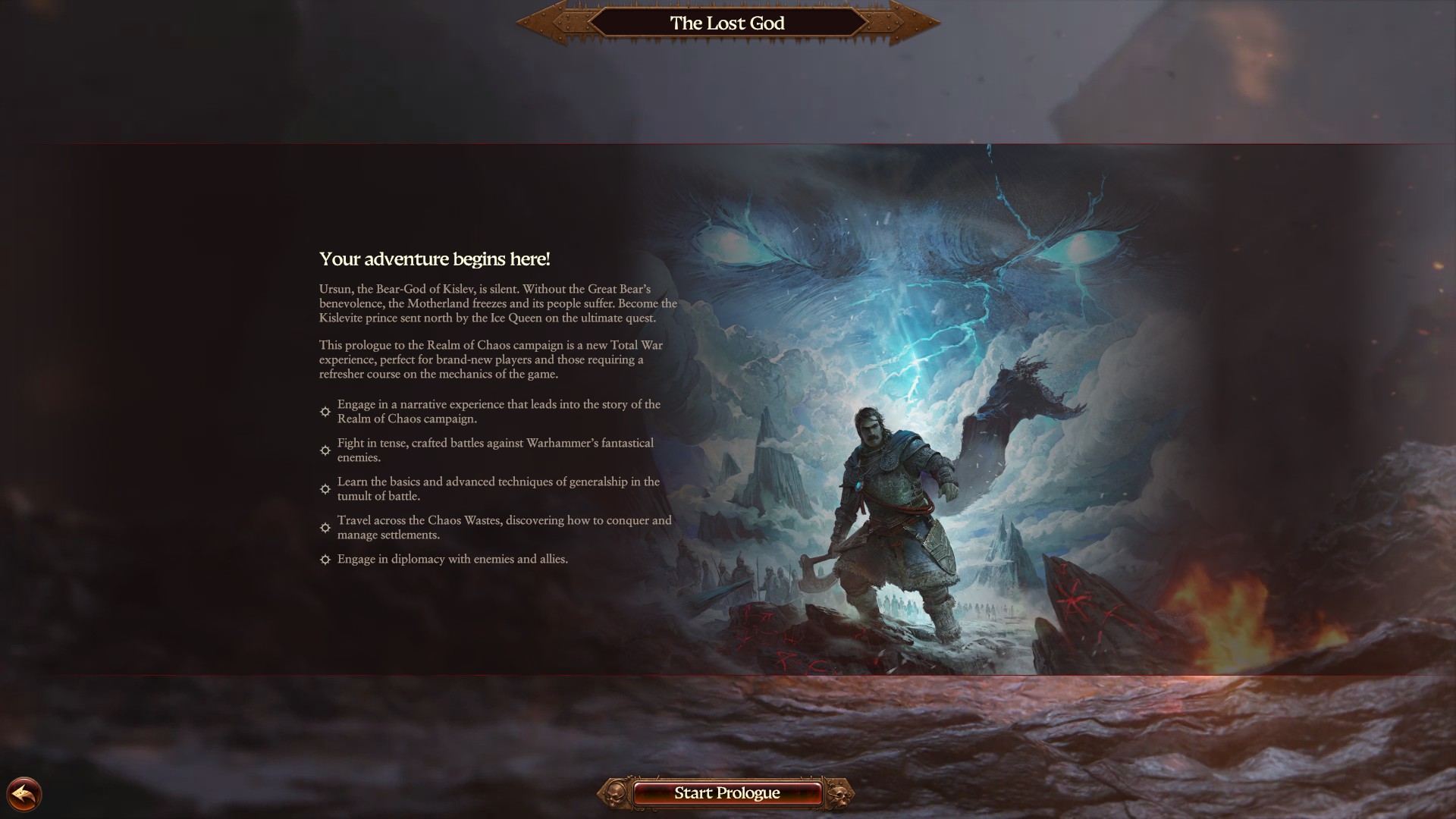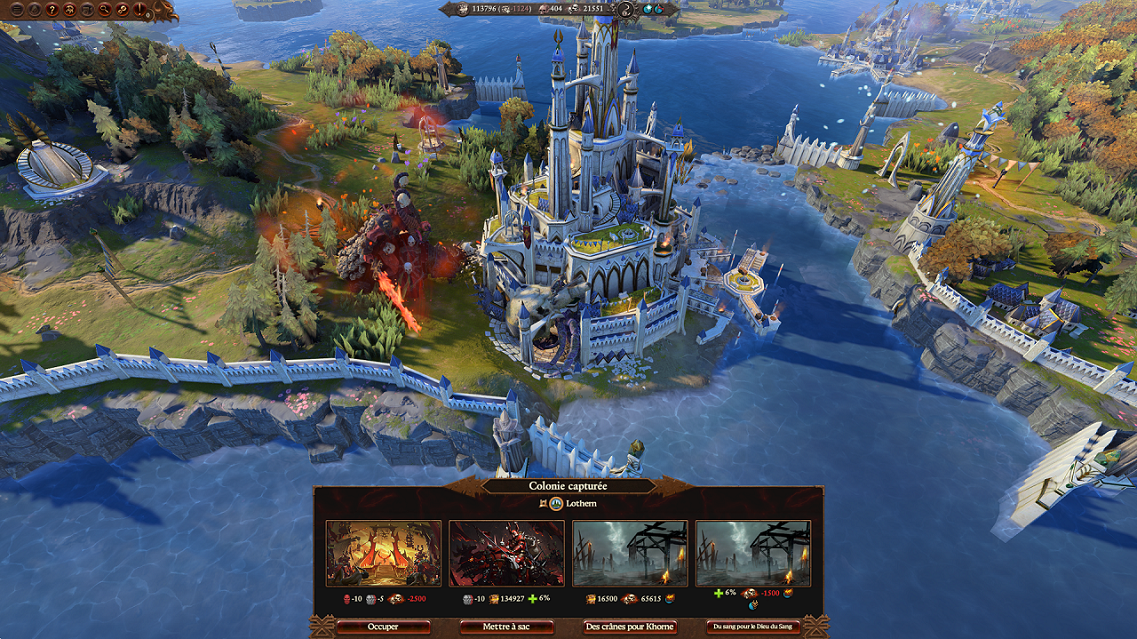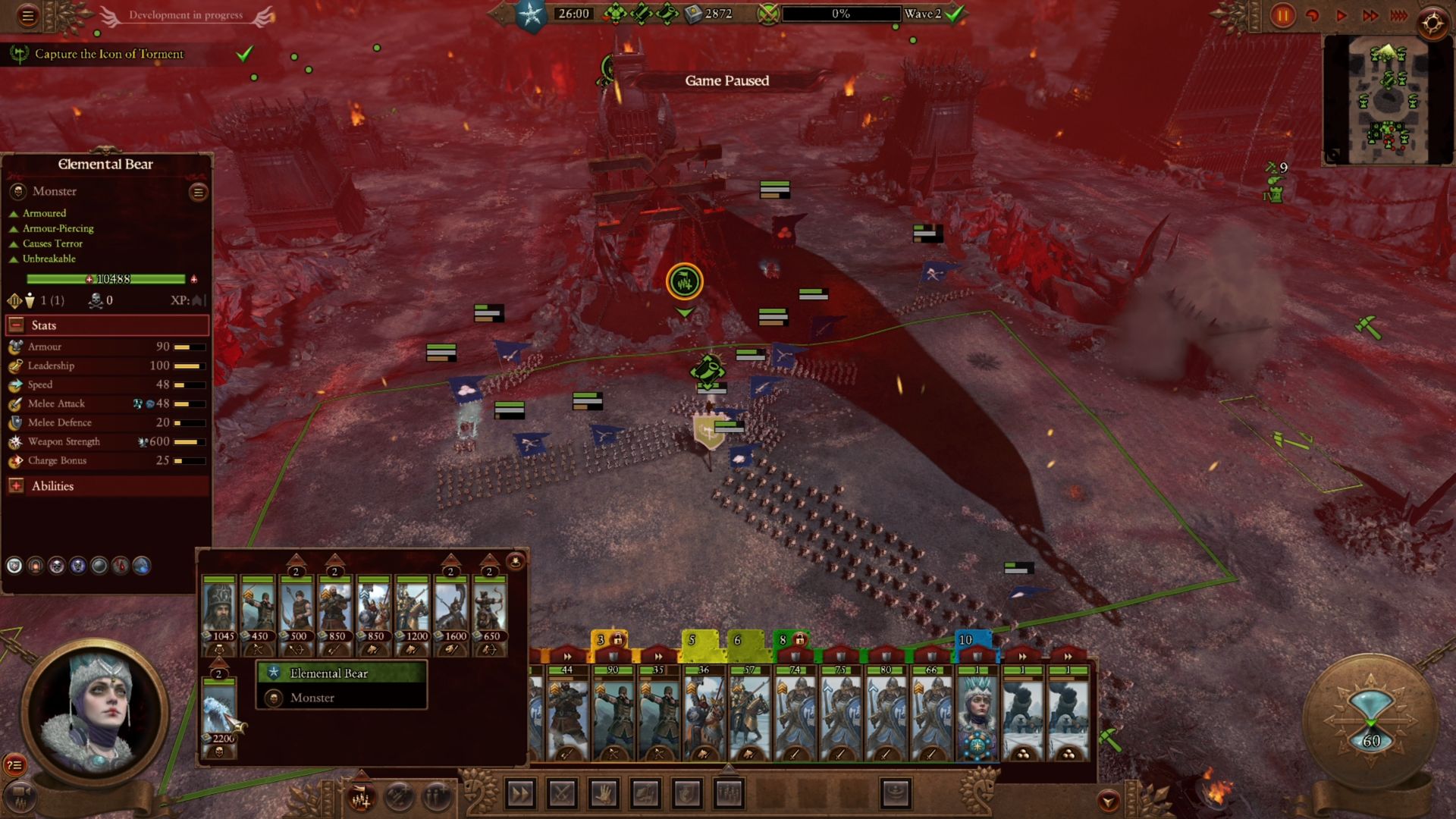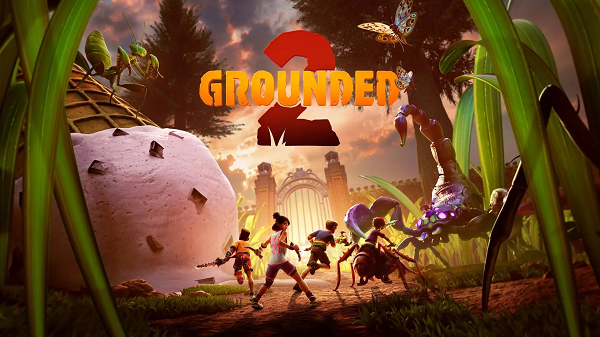Advertisement
Popular Now
Total War: Warhammer III is a monumental strategy game that blends intricate turn-based campaign management with thrilling real-time battles in a fantasy world steeped in Warhammer lore. With its vast array of factions, unique mechanics, and complex systems, the game can be daunting for newcomers and challenging even for seasoned players. This guide provides a comprehensive set of tips and strategies to help you dominate both the campaign map and the battlefield. From choosing the right faction to mastering advanced battle tactics, these insights will equip you to conquer the Chaos-infested world of Warhammer III. Whether you're leading the disciplined armies of Grand Cathay or the bloodthirsty hordes of Khorne, this article covers essential advice to elevate your gameplay.
 The prologue in Total War: Warhammer III is an excellent starting point for new players, offering a guided introduction to the game’s core mechanics. Unlike many tutorials, it weaves a narrative-driven campaign that teaches you how to manage settlements, recruit armies, and engage in battles without overwhelming you. Playing through the prologue as Kislev’s Yuri Barkov introduces key concepts like diplomacy, unit management, and the Chaos Realms, making it easier to grasp the game’s complexity before diving into a full campaign.
Even if you’re a veteran of the Total War series, the prologue is worth playing to understand Warhammer III’s unique features, such as the reworked diplomacy system and Chaos corruption mechanics. It takes about 2-3 hours to complete and provides a low-stakes environment to experiment with controls and strategies. Skipping it might save time initially, but you risk missing critical nuances that could make your first campaign smoother.
The prologue in Total War: Warhammer III is an excellent starting point for new players, offering a guided introduction to the game’s core mechanics. Unlike many tutorials, it weaves a narrative-driven campaign that teaches you how to manage settlements, recruit armies, and engage in battles without overwhelming you. Playing through the prologue as Kislev’s Yuri Barkov introduces key concepts like diplomacy, unit management, and the Chaos Realms, making it easier to grasp the game’s complexity before diving into a full campaign.
Even if you’re a veteran of the Total War series, the prologue is worth playing to understand Warhammer III’s unique features, such as the reworked diplomacy system and Chaos corruption mechanics. It takes about 2-3 hours to complete and provides a low-stakes environment to experiment with controls and strategies. Skipping it might save time initially, but you risk missing critical nuances that could make your first campaign smoother.
 With over 20 races and 95 legendary lords available in Immortal Empires, selecting the right faction is crucial for a manageable start. For beginners, Grand Cathay (led by Zhao Ming) and Kislev (led by Tzarina Katarin) are highly recommended due to their forgiving starting positions and straightforward mechanics. Grand Cathay’s defensive playstyle and robust economy, bolstered by the Ivory Road caravan system, make it ideal for learning resource management. Kislev, meanwhile, offers a balanced roster with strong infantry and hybrid units, perfect for mastering both campaign and combat.
Khorne’s Exiles, led by Skarbrand, is another option for players who prefer aggressive, melee-focused gameplay. Their Bloodletting mechanic rewards constant combat with buffs like reduced upkeep and faster recruitment, but it requires careful resource management. Avoid factions like Skaven or Vampire Coast early on, as their complex mechanics (e.g., loyalty or disposable troops) can overwhelm new players.
With over 20 races and 95 legendary lords available in Immortal Empires, selecting the right faction is crucial for a manageable start. For beginners, Grand Cathay (led by Zhao Ming) and Kislev (led by Tzarina Katarin) are highly recommended due to their forgiving starting positions and straightforward mechanics. Grand Cathay’s defensive playstyle and robust economy, bolstered by the Ivory Road caravan system, make it ideal for learning resource management. Kislev, meanwhile, offers a balanced roster with strong infantry and hybrid units, perfect for mastering both campaign and combat.
Khorne’s Exiles, led by Skarbrand, is another option for players who prefer aggressive, melee-focused gameplay. Their Bloodletting mechanic rewards constant combat with buffs like reduced upkeep and faster recruitment, but it requires careful resource management. Avoid factions like Skaven or Vampire Coast early on, as their complex mechanics (e.g., loyalty or disposable troops) can overwhelm new players.
 A strong economy is the backbone of any successful campaign in Total War: Warhammer III. Focus on constructing buildings that generate income, such as trade resource buildings (e.g., timber or gold mines) and markets, early in the game. For factions like Empire, Dwarfs, or Bretonnia, trade agreements with friendly factions can significantly boost your treasury. Use the diplomacy menu’s “Quick Deal” option to identify trade partners and secure deals for “free money.”
Balance your spending carefully—avoid over-recruiting units early on, as army upkeep can drain your funds. Instead, invest in infrastructure to grow your settlements, which unlocks higher-tier buildings and better units. For Grand Cathay, maintain Yin and Yang harmony to maximize economic bonuses, as imbalance can cripple your income and growth. Always build defensive structures, like garrisons, to protect your settlements from invasions or Chaos rifts.
A strong economy is the backbone of any successful campaign in Total War: Warhammer III. Focus on constructing buildings that generate income, such as trade resource buildings (e.g., timber or gold mines) and markets, early in the game. For factions like Empire, Dwarfs, or Bretonnia, trade agreements with friendly factions can significantly boost your treasury. Use the diplomacy menu’s “Quick Deal” option to identify trade partners and secure deals for “free money.”
Balance your spending carefully—avoid over-recruiting units early on, as army upkeep can drain your funds. Instead, invest in infrastructure to grow your settlements, which unlocks higher-tier buildings and better units. For Grand Cathay, maintain Yin and Yang harmony to maximize economic bonuses, as imbalance can cripple your income and growth. Always build defensive structures, like garrisons, to protect your settlements from invasions or Chaos rifts.
 Building a balanced army is critical for success in Warhammer III’s battles. A good starting composition includes a frontline of infantry to hold the line, ranged units for damage, and cavalry or fast units for flanking. For example, High Elves excel with strong ranged units like Sisters of Avelorn, while Bretonnia relies on heavy cavalry. Always include at least one artillery piece to force enemies to engage you or to break down settlement walls.
Ranged units dominate Warhammer III’s meta, so dedicate 60-75% of your army to archers, crossbowmen, or artillery, especially for factions like Cathay or Kislev. Protect them with a sturdy frontline, such as Cathay’s Jade Warriors or Kislev’s Ice Guard. Avoid clustering units too tightly, as this makes them vulnerable to spells or artillery. Use the chequerboard formation to maximize ranged unit efficiency while maintaining defensive integrity.
Building a balanced army is critical for success in Warhammer III’s battles. A good starting composition includes a frontline of infantry to hold the line, ranged units for damage, and cavalry or fast units for flanking. For example, High Elves excel with strong ranged units like Sisters of Avelorn, while Bretonnia relies on heavy cavalry. Always include at least one artillery piece to force enemies to engage you or to break down settlement walls.
Ranged units dominate Warhammer III’s meta, so dedicate 60-75% of your army to archers, crossbowmen, or artillery, especially for factions like Cathay or Kislev. Protect them with a sturdy frontline, such as Cathay’s Jade Warriors or Kislev’s Ice Guard. Avoid clustering units too tightly, as this makes them vulnerable to spells or artillery. Use the chequerboard formation to maximize ranged unit efficiency while maintaining defensive integrity.
 Combat in Warhammer III is complex but rewarding. Use the “hammer and anvil” tactic: engage enemies with infantry (the anvil) and flank with cavalry or fast units (the hammer) to break their morale. Protect ranged units by positioning them behind infantry, and use the tactical map (Tab key) to monitor the battlefield and avoid being flanked. Pause frequently to issue commands, especially when managing multiple units or casting spells.
Flanking is critical—attack enemy units from the sides or rear to maximize damage and reduce their leadership. Use terrain to your advantage, such as placing ranged units on hills for better line of sight. For factions like Khorne, focus on melee dominance, while Cathay benefits from defensive formations that draw enemies into ranged fire. Experiment with custom battles to practice tactics without risking your campaign.
Combat in Warhammer III is complex but rewarding. Use the “hammer and anvil” tactic: engage enemies with infantry (the anvil) and flank with cavalry or fast units (the hammer) to break their morale. Protect ranged units by positioning them behind infantry, and use the tactical map (Tab key) to monitor the battlefield and avoid being flanked. Pause frequently to issue commands, especially when managing multiple units or casting spells.
Flanking is critical—attack enemy units from the sides or rear to maximize damage and reduce their leadership. Use terrain to your advantage, such as placing ranged units on hills for better line of sight. For factions like Khorne, focus on melee dominance, while Cathay benefits from defensive formations that draw enemies into ranged fire. Experiment with custom battles to practice tactics without risking your campaign.
1. Start with the Prologue
 The prologue in Total War: Warhammer III is an excellent starting point for new players, offering a guided introduction to the game’s core mechanics. Unlike many tutorials, it weaves a narrative-driven campaign that teaches you how to manage settlements, recruit armies, and engage in battles without overwhelming you. Playing through the prologue as Kislev’s Yuri Barkov introduces key concepts like diplomacy, unit management, and the Chaos Realms, making it easier to grasp the game’s complexity before diving into a full campaign.
Even if you’re a veteran of the Total War series, the prologue is worth playing to understand Warhammer III’s unique features, such as the reworked diplomacy system and Chaos corruption mechanics. It takes about 2-3 hours to complete and provides a low-stakes environment to experiment with controls and strategies. Skipping it might save time initially, but you risk missing critical nuances that could make your first campaign smoother.
The prologue in Total War: Warhammer III is an excellent starting point for new players, offering a guided introduction to the game’s core mechanics. Unlike many tutorials, it weaves a narrative-driven campaign that teaches you how to manage settlements, recruit armies, and engage in battles without overwhelming you. Playing through the prologue as Kislev’s Yuri Barkov introduces key concepts like diplomacy, unit management, and the Chaos Realms, making it easier to grasp the game’s complexity before diving into a full campaign.
Even if you’re a veteran of the Total War series, the prologue is worth playing to understand Warhammer III’s unique features, such as the reworked diplomacy system and Chaos corruption mechanics. It takes about 2-3 hours to complete and provides a low-stakes environment to experiment with controls and strategies. Skipping it might save time initially, but you risk missing critical nuances that could make your first campaign smoother.
Why It Matters
The prologue ensures you’re familiar with the game’s interface, from the campaign map to battle controls, reducing the learning curve. It also introduces faction-specific mechanics, which vary significantly between races.2. Choose a Beginner-Friendly Faction
 With over 20 races and 95 legendary lords available in Immortal Empires, selecting the right faction is crucial for a manageable start. For beginners, Grand Cathay (led by Zhao Ming) and Kislev (led by Tzarina Katarin) are highly recommended due to their forgiving starting positions and straightforward mechanics. Grand Cathay’s defensive playstyle and robust economy, bolstered by the Ivory Road caravan system, make it ideal for learning resource management. Kislev, meanwhile, offers a balanced roster with strong infantry and hybrid units, perfect for mastering both campaign and combat.
Khorne’s Exiles, led by Skarbrand, is another option for players who prefer aggressive, melee-focused gameplay. Their Bloodletting mechanic rewards constant combat with buffs like reduced upkeep and faster recruitment, but it requires careful resource management. Avoid factions like Skaven or Vampire Coast early on, as their complex mechanics (e.g., loyalty or disposable troops) can overwhelm new players.
With over 20 races and 95 legendary lords available in Immortal Empires, selecting the right faction is crucial for a manageable start. For beginners, Grand Cathay (led by Zhao Ming) and Kislev (led by Tzarina Katarin) are highly recommended due to their forgiving starting positions and straightforward mechanics. Grand Cathay’s defensive playstyle and robust economy, bolstered by the Ivory Road caravan system, make it ideal for learning resource management. Kislev, meanwhile, offers a balanced roster with strong infantry and hybrid units, perfect for mastering both campaign and combat.
Khorne’s Exiles, led by Skarbrand, is another option for players who prefer aggressive, melee-focused gameplay. Their Bloodletting mechanic rewards constant combat with buffs like reduced upkeep and faster recruitment, but it requires careful resource management. Avoid factions like Skaven or Vampire Coast early on, as their complex mechanics (e.g., loyalty or disposable troops) can overwhelm new players.
Faction Highlights
- Grand Cathay: Strong economy, defensive units, and safe starting position.
- Kislev: Balanced roster, ideal for learning hybrid tactics.
- Khorne: Aggressive playstyle, rewarding for combat-focused players.
3. Prioritize Economy Building
 A strong economy is the backbone of any successful campaign in Total War: Warhammer III. Focus on constructing buildings that generate income, such as trade resource buildings (e.g., timber or gold mines) and markets, early in the game. For factions like Empire, Dwarfs, or Bretonnia, trade agreements with friendly factions can significantly boost your treasury. Use the diplomacy menu’s “Quick Deal” option to identify trade partners and secure deals for “free money.”
Balance your spending carefully—avoid over-recruiting units early on, as army upkeep can drain your funds. Instead, invest in infrastructure to grow your settlements, which unlocks higher-tier buildings and better units. For Grand Cathay, maintain Yin and Yang harmony to maximize economic bonuses, as imbalance can cripple your income and growth. Always build defensive structures, like garrisons, to protect your settlements from invasions or Chaos rifts.
A strong economy is the backbone of any successful campaign in Total War: Warhammer III. Focus on constructing buildings that generate income, such as trade resource buildings (e.g., timber or gold mines) and markets, early in the game. For factions like Empire, Dwarfs, or Bretonnia, trade agreements with friendly factions can significantly boost your treasury. Use the diplomacy menu’s “Quick Deal” option to identify trade partners and secure deals for “free money.”
Balance your spending carefully—avoid over-recruiting units early on, as army upkeep can drain your funds. Instead, invest in infrastructure to grow your settlements, which unlocks higher-tier buildings and better units. For Grand Cathay, maintain Yin and Yang harmony to maximize economic bonuses, as imbalance can cripple your income and growth. Always build defensive structures, like garrisons, to protect your settlements from invasions or Chaos rifts.
Key Economic Tips
- Build resource-generating buildings in every settlement.
- Secure trade agreements early for passive income.
- Maintain a surplus to avoid bankruptcy during unexpected wars.
4. Master Diplomacy to Avoid Overextension
Diplomacy in Warhammer III is more robust than in previous titles, offering tools like outposts and war coordination to strengthen alliances. Early in the game, prioritize non-aggression pacts with neighboring factions to avoid fighting on multiple fronts. For example, as Kislev, securing a defensive alliance with a nearby faction can deter early invasions. Be cautious about breaking treaties, as low reliability makes other factions less likely to deal with you. Outposts are a game-changer—build them in allied province capitals to recruit their units, creating powerful army compositions (e.g., Cathay’s missile units paired with Dwarf infantry). Use the allegiance panel to coordinate with allies, directing them to attack specific targets. Avoid declaring war unnecessarily; focus on one or two enemies at a time to prevent your resources from being stretched thin.Diplomatic Strategies
- Sign non-aggression pacts to secure borders.
- Build outposts for allied unit recruitment.
- Monitor reliability to maintain trust with other factions.
5. Understand Faction-Specific Mechanics
Each faction in Warhammer III has unique mechanics that shape its campaign. For example, Grand Cathay’s Harmony system requires balancing Yin and Yang buildings to optimize economy and control. Kislev’s devotion and supporter mechanics involve an internal power struggle, where you must outpace rival factions to unify the nation. Khorne’s Bloodletting mechanic rewards constant victories with powerful buffs, while Skaven rely on food to upgrade settlements quickly. Read in-game pop-ups carefully to understand these mechanics, as ignoring them can lead to costly mistakes (e.g., neglecting loyalty as Skaven can cause rebellions). Experiment with your faction’s strengths—Cathay’s caravans generate wealth, while Khorne thrives on razing settlements. Tailor your strategy to your faction’s goals, such as securing the Great Bastion as Miao Ying to fend off Chaos invasions.Faction Mechanic Examples
- Cathay: Balance Yin and Yang for economic boosts.
- Kislev: Gain supporters to unify factions.
- Khorne: Fight constantly to stack Bloodletting buffs.
6. Optimize Army Composition
 Building a balanced army is critical for success in Warhammer III’s battles. A good starting composition includes a frontline of infantry to hold the line, ranged units for damage, and cavalry or fast units for flanking. For example, High Elves excel with strong ranged units like Sisters of Avelorn, while Bretonnia relies on heavy cavalry. Always include at least one artillery piece to force enemies to engage you or to break down settlement walls.
Ranged units dominate Warhammer III’s meta, so dedicate 60-75% of your army to archers, crossbowmen, or artillery, especially for factions like Cathay or Kislev. Protect them with a sturdy frontline, such as Cathay’s Jade Warriors or Kislev’s Ice Guard. Avoid clustering units too tightly, as this makes them vulnerable to spells or artillery. Use the chequerboard formation to maximize ranged unit efficiency while maintaining defensive integrity.
Building a balanced army is critical for success in Warhammer III’s battles. A good starting composition includes a frontline of infantry to hold the line, ranged units for damage, and cavalry or fast units for flanking. For example, High Elves excel with strong ranged units like Sisters of Avelorn, while Bretonnia relies on heavy cavalry. Always include at least one artillery piece to force enemies to engage you or to break down settlement walls.
Ranged units dominate Warhammer III’s meta, so dedicate 60-75% of your army to archers, crossbowmen, or artillery, especially for factions like Cathay or Kislev. Protect them with a sturdy frontline, such as Cathay’s Jade Warriors or Kislev’s Ice Guard. Avoid clustering units too tightly, as this makes them vulnerable to spells or artillery. Use the chequerboard formation to maximize ranged unit efficiency while maintaining defensive integrity.
Sample Army Composition
- Frontline: 6-8 infantry units (e.g., spearmen or swordsmen).
- Ranged: 6-8 archers or artillery for damage.
- Flanks: 2-4 cavalry or fast units for flanking.
7. Master Battle Tactics
 Combat in Warhammer III is complex but rewarding. Use the “hammer and anvil” tactic: engage enemies with infantry (the anvil) and flank with cavalry or fast units (the hammer) to break their morale. Protect ranged units by positioning them behind infantry, and use the tactical map (Tab key) to monitor the battlefield and avoid being flanked. Pause frequently to issue commands, especially when managing multiple units or casting spells.
Flanking is critical—attack enemy units from the sides or rear to maximize damage and reduce their leadership. Use terrain to your advantage, such as placing ranged units on hills for better line of sight. For factions like Khorne, focus on melee dominance, while Cathay benefits from defensive formations that draw enemies into ranged fire. Experiment with custom battles to practice tactics without risking your campaign.
Combat in Warhammer III is complex but rewarding. Use the “hammer and anvil” tactic: engage enemies with infantry (the anvil) and flank with cavalry or fast units (the hammer) to break their morale. Protect ranged units by positioning them behind infantry, and use the tactical map (Tab key) to monitor the battlefield and avoid being flanked. Pause frequently to issue commands, especially when managing multiple units or casting spells.
Flanking is critical—attack enemy units from the sides or rear to maximize damage and reduce their leadership. Use terrain to your advantage, such as placing ranged units on hills for better line of sight. For factions like Khorne, focus on melee dominance, while Cathay benefits from defensive formations that draw enemies into ranged fire. Experiment with custom battles to practice tactics without risking your campaign.
Key Battle Tips
- Use “hammer and anvil” for quick victories.
- Pause to manage complex battles.
- Position ranged units on elevated terrain.
8. Level Up Lords and Heroes Effectively
Lords and Heroes are pivotal in Warhammer III, with a max rank of 50 and expanded skill trees. Prioritize the top-line skills to boost their personal combat abilities or spells, especially for magic-users who can earn XP by dealing damage. Legendary Lords unlock unique skills between levels 10-20, which should be prioritized for their powerful effects. For example, Skarbrand’s melee buffs make him a one-man army, while Zhao Ming’s economic bonuses enhance your campaign. Balance skill points between personal abilities (top line), army buffs (middle line), and campaign bonuses (bottom line). For combat-focused lords, invest in red-line skills to enhance your army’s infantry or ranged units. Use heroes for scouting or assassination to weaken enemy armies before battles. Avoid spreading points too thinly—focus on synergies that match your playstyle.Skill Tree Priorities
- Top Line: Boosts personal combat or spells.
- Middle Line: Enhances army performance.
- Bottom Line: Improves campaign map bonuses.
9. Manage Chaos Corruption
Chaos corruption is a major threat in Warhammer III, especially in the Realms of Chaos campaign. It spreads through rifts and enemy presence, reducing public order and causing rebellions. Build anti-corruption buildings (e.g., Kislev’s churches or Cathay’s shrines) in every province to mitigate its effects. For factions like Khorne or Nurgle, embrace corruption to gain buffs, but be prepared to counter enemy corruption types. In the Realms of Chaos, close rifts using heroes or armies to prevent enemy invasions. For Cathay, maintaining the Great Bastion is critical to block Chaos invasions from the north. Monitor corruption levels via the province details panel and act quickly to prevent uprisings. Balancing corruption management with expansion is key to maintaining a stable empire.Corruption Countermeasures
- Build anti-corruption buildings in every province.
- Close Chaos rifts promptly.
- Use heroes to spread your faction’s corruption in enemy territory.
10. Plan for Immortal Empires
Immortal Empires, the massive sandbox campaign combining all three Warhammer games, is the ultimate experience for Warhammer III players. It requires ownership of Warhammer I and II for full access to all factions, but even the base game offers a vast map with diverse challenges. Tailor your strategy to your faction’s victory objectives, such as conquering specific settlements or eliminating rival factions. Avoid alliances with factions you need to destroy, as this can complicate objectives. Start with a faction you’re comfortable with, like High Elves or Lizardmen, for a more forgiving experience. Plan your expansion carefully—overextending can leave you vulnerable to multiple enemies. Use online resources like Zerkovich’s YouTube guides or the Total War subreddit for faction-specific strategies and updates. Immortal Empires rewards experimentation, so don’t be afraid to restart campaigns to refine your approach.Immortal Empires Tips
- Focus on victory objectives from the start.
- Secure a defensible province before expanding.
- Watch YouTube guides for advanced faction strategies.
















